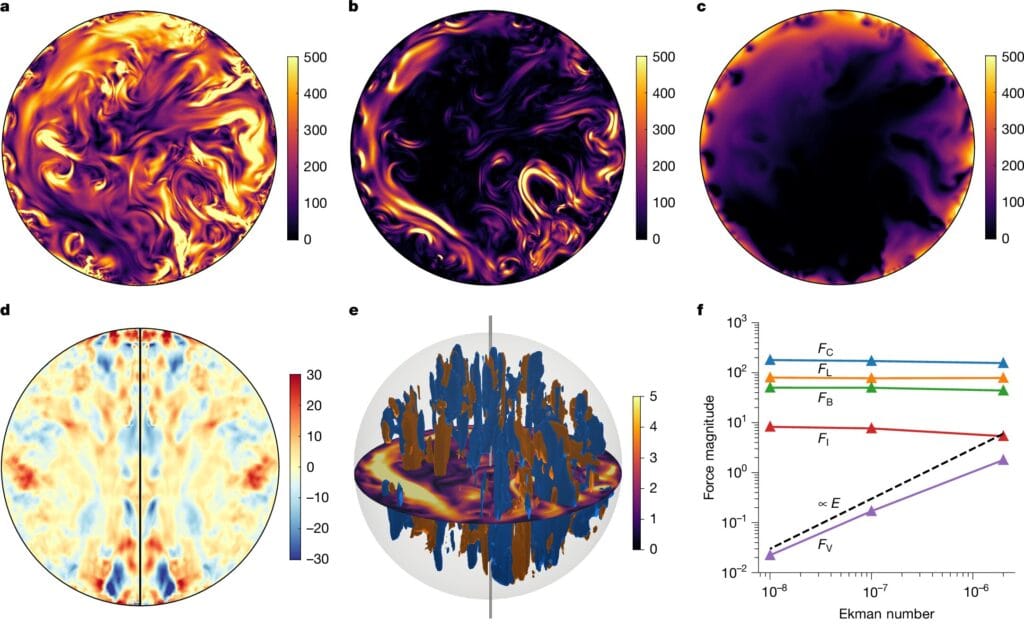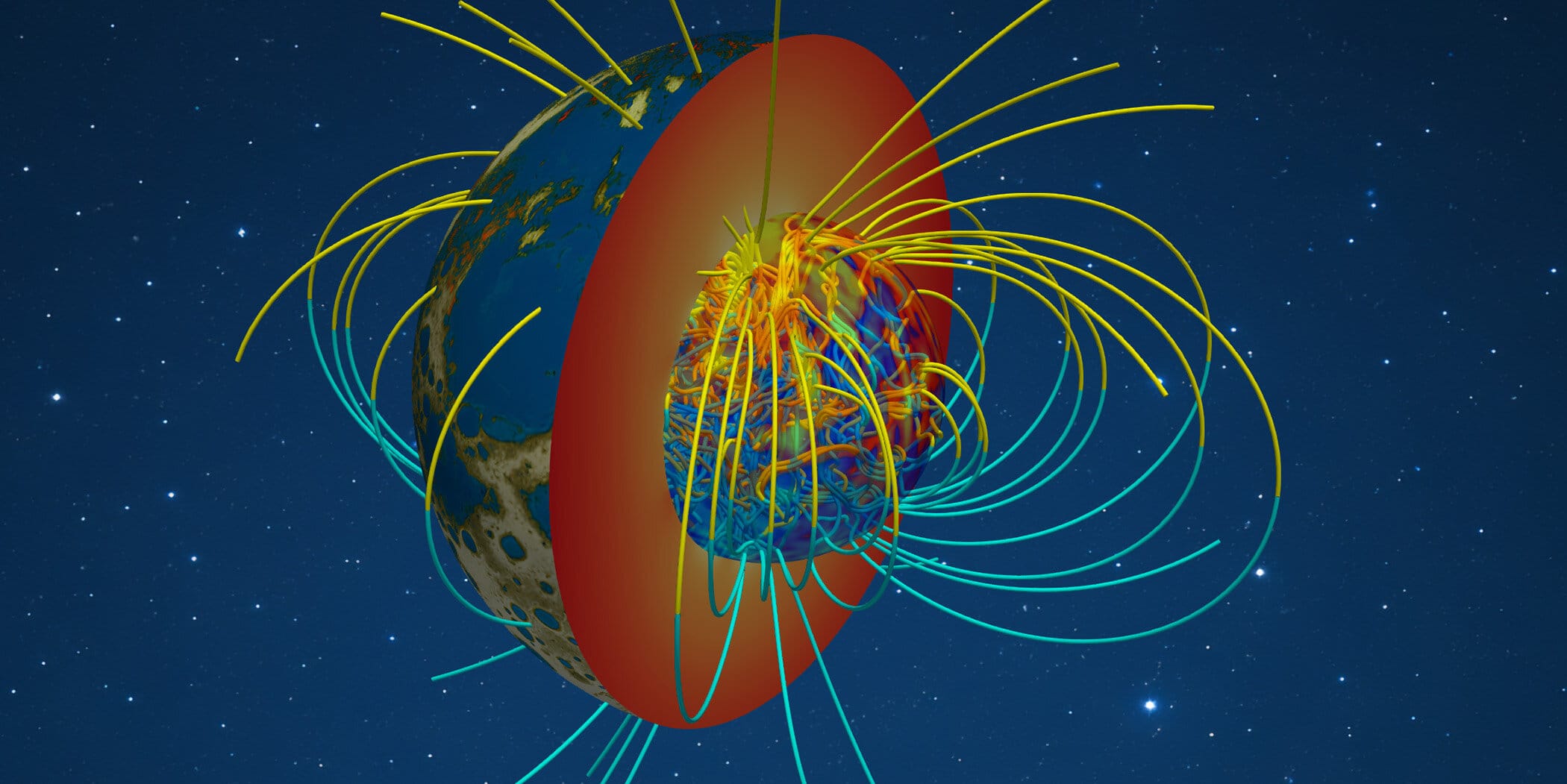High above our heads, an invisible shield guards our planet. We don’t see it, we don’t feel it, but without it, life as we know it may never have evolved. This powerful force is Earth’s magnetic field, a vast cocoon that deflects harmful cosmic radiation and solar winds that would otherwise strip away our atmosphere and irradiate our planet’s surface.
While Mars remains a sterile wasteland, bombarded by deadly particles, Earth thrives in part because of this protective barrier. Yet, despite its importance, scientists have long been puzzled by a mystery at the heart of our world—literally. How was Earth able to generate its magnetic field billions of years ago, long before its core had begun to solidify?
Now, a team of geophysicists from ETH Zurich in Switzerland and the Southern University of Science and Technology (SUSTech) in China have cracked the mystery wide open. Their new research, published in Nature, provides compelling evidence that Earth’s magnetic field was born far earlier than previously believed—under conditions that, until now, scientists struggled to model.
The Dynamo Theory—and Its Longstanding Puzzle
The magnetic field surrounding Earth is generated by a process known as the geodynamo. According to this theory, the movement of molten iron and nickel within the planet’s outer core creates powerful electrical currents. These currents, in turn, produce magnetic fields. Over time, the combination of Earth’s rotation and these dynamic, swirling motions generates a global magnetic field, like a colossal bar magnet embedded in the planet.
However, there’s been a major problem with this model. The modern dynamo effect relies on the presence of a solid inner core, which provides additional buoyancy and heat gradients that drive the flow of molten metal. But Earth’s solid inner core only began to crystallize around 1 billion years ago—long after life first appeared.
If the dynamo requires a solid inner core, how was Earth generating a magnetic field during its earliest history, when the entire core was molten?
Until recently, this question was considered one of the major gaps in our understanding of Earth’s evolution.
Simulating a Liquid Core: A New Answer Emerges
The key breakthrough came through the use of sophisticated computer simulations. Because Earth’s deep interior is inaccessible, researchers must recreate its conditions virtually. The team, led by geophysicist Yufeng Lin, built a complex computational model of Earth’s liquid core using some of the world’s most advanced resources—including the Piz Daint supercomputer at the Swiss National Supercomputing Centre in Lugano.

What they found was astonishing.
By adjusting the model to reflect the correct physical regime—specifically minimizing the influence of viscosity, or internal friction—they discovered that a fully liquid core can, in fact, generate a stable, self-sustaining magnetic field. The dynamo effect doesn’t require a solid inner core after all. In the right conditions, the swirling motions of molten iron alone are enough to create the protective magnetosphere we depend on today.
“Until now, no one has ever managed to perform such calculations under these correct physical conditions,” Lin said. “This is the first time we’ve been able to simulate Earth’s early core with such minimal viscosity that the results align with the physics we expect.”
A Shield That Helped Life Take Root
The implications of this finding are profound. If Earth’s magnetic field was active earlier than we thought—possibly more than 4 billion years ago—then the timing coincides with the earliest signs of life on Earth.
This means that life did not emerge despite a harsh, radiation-filled environment. It may have flourished because a magnetic field was already in place, shielding the surface from sterilizing cosmic particles and helping retain an atmosphere rich in water vapor and carbon dioxide.
“Understanding when Earth’s magnetic field was active gives us insights into the environmental conditions that early life experienced,” said Andy Jackson, co-author of the study and professor of geophysics at ETH Zurich. “This discovery reframes our assumptions about the habitability of the early Earth.”
Looking Beyond Earth
The study’s insights extend beyond our own planet. If a fully liquid core can support a magnetic field, then other planets and moons in our solar system—or even beyond—might once have had, or still have, magnetic shields.
This opens new doors in the search for life in the cosmos. Jupiter’s moon Ganymede, for example, has a magnetic field, as does Mercury, despite its small size. Understanding the diversity of dynamo mechanisms could help researchers evaluate which celestial bodies are more likely to have habitable conditions.
It may also help to understand the strange history of Mars, which once had a magnetic field but lost it. Without that protection, solar winds stripped away much of its atmosphere, and the planet became the barren world we see today. Could a similar fate await Earth if our own dynamo were to falter?
A Magnetic Field in Flux
Earth’s magnetic field is not static. Over geological time, it has reversed polarity thousands of times—meaning magnetic north becomes south and vice versa. These flips are recorded in the alignment of iron particles in ancient lava flows, offering scientists a timeline of our planet’s magnetic past.
In more recent decades, researchers have observed a rapid movement of the magnetic north pole, shifting toward Siberia at unprecedented speeds. Some speculate this could be a prelude to another full reversal. While a magnetic flip wouldn’t be catastrophic in itself, it could have major implications for navigation systems, satellite communication, and power grids, all of which rely on the stability of Earth’s magnetic field.
Understanding how the magnetic field is generated and what maintains it is therefore not only a question of academic curiosity—it’s a matter of global importance.
“If we understand how the magnetic field is generated, we can predict its future development,” Jackson emphasized. “That has real-world consequences for how we prepare for changes in space weather and technological disruptions.”
Earth’s Greatest Silent Hero
The magnetic field is one of Earth’s most underappreciated features—a silent guardian that has shaped the planet’s atmosphere, geology, and biosphere since deep time. Without it, Earth might resemble Mars: a lifeless rock, stripped of air and scorched by radiation.
This new research confirms that Earth’s magnetic field has likely protected the planet for nearly its entire history, possibly making the emergence and evolution of life possible far earlier than previously believed.
It’s a scientific revelation that’s as humbling as it is inspiring. Deep beneath our feet, in the swirling chaos of molten metal, lies the engine of one of the most crucial features of our world. We owe our very existence to the invisible, ancient dance of Earth’s core—a dance that began long before the first microbe ever stirred in the oceans.
And now, thanks to the work of Lin, Jackson, and their team, we are one step closer to understanding it.
More information: Yufeng Lin et al, Invariance of dynamo action in an early-Earth model, Nature (2025). DOI: 10.1038/s41586-025-09334-y






